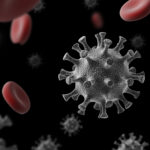
Your respiratory system is one of the most important systems in your body– but it faces a number of hazards. From the common cold and flu to RSV and COVID-19, your respiratory system can get lots of different illnesses. Since one of the most common symptoms of respiratory illnesses is impeded breathing through lung function difficulties or nasal or sinus congestion, these illnesses are often very unpleasant to deal with. Let’s take a deeper look at the causes of respiratory diseases and how to avoid common respiratory infections as best as you can. With respiratory illnesses on the rise, it’s important to understand how.
Understanding the Respiratory System
In order to best understand how the respiratory system gets sick, you need to know the different parts and how they work together.
The respiratory system is essentially a loop that air travels through. With each breath, new air comes in through the nose, as old air leaves the same way. This whole pathway is called the respiratory tract, and is divided into two parts: the upper respiratory tract and the lower respiratory tract. The upper respiratory tract includes the nose, nasal cavity, pharynx, and larynx, while the lower respiratory tract includes the trachea, bronchi, bronchioles, and lungs.
The nose, with its intricate network of tiny hairs and mucous membranes, serves as the entry point for inhaled air. As air travels through the nasal passages, it is warmed, humidified, and filtered before reaching the lungs. The pharynx and larynx are muscular tubes in your throat. They play crucial roles in directing air to the trachea, another muscular tube that ensures the passage of air to the bronchi.
The bronchi, branching out into smaller bronchioles, are passageways that let air come deep into the lungs. Within the lungs, millions of tiny air sacs called alveoli facilitate the exchange of gasses. Oxygen diffuses into the bloodstream, while carbon dioxide exits the body through exhalation. This process, known as gas exchange, occurs in the alveoli.
So, now that you know the different parts of the respiratory system, how do those parts get sick? Let’s explore how respiratory viruses work, as well as other transmission methods.
How Respiratory System Illnesses Occur
Respiratory system illnesses, often caused by viruses, bacteria, or other pathogens, are among the most prevalent issues affecting the respiratory system. The upper respiratory tract is commonly affected by conditions like the common cold, influenza, and various types of sore throats. The lower respiratory tract can be impacted by things like bronchitis and pneumonia– more on those in a bit. These infections often spread through respiratory droplets when an infected person coughs or sneezes, or by touching surfaces contaminated with the virus.
Respiratory viruses are a diverse group of pathogens that primarily infect the respiratory system, causing a range of illnesses from mild colds to severe respiratory diseases. The most common respiratory viruses include influenza viruses, rhinoviruses (which cause the common cold), coronaviruses (such as the common cold viruses and more recently, the SARS-CoV-2 virus responsible for COVID-19), respiratory syncytial virus (RSV), adenoviruses, and others.
Bacterial and fungal infections can also cause respiratory illnesses. Bacterial infections, such as those caused by Streptococcus pneumoniae or Mycobacterium tuberculosis, can lead to conditions like pneumonia or bronchitis, triggering inflammation, fluid accumulation, and impaired lung function. Bacteria often invade lung tissues, causing damage and prompting the immune system to mount an inflammatory response.
Fungal infections, such as those from Aspergillus or Candida species, can also cause infections, especially people with compromised immune systems. Fungi may colonize the respiratory tract, leading to conditions like fungal pneumonia or bronchopulmonary aspergillosis, resulting in respiratory symptoms, lung tissue damage, and, in severe cases, systemic dissemination. Both bacterial and fungal infections highlight the diverse range of respiratory diseases, necessitating targeted treatments and management approaches based on the specific pathogens involved.
Common Respiratory Infections
Common Colds and Upper Respiratory Infections
The common cold, often caused by rhinoviruses, is one of the most prevalent respiratory ailments. It typically manifests with symptoms like a runny or stuffy nose, sneezing, coughing, and a sore throat. Other respiratory viruses, including coronaviruses and adenoviruses, can also lead to upper respiratory infections. These viruses spread through respiratory droplets, making close contact with an infected person or touching contaminated surfaces common modes of transmission.
The Flu
Influenza, or the flu, is another respiratory infection with symptoms that overlap with the common cold but are often more severe. Fever, body aches, fatigue, and a persistent cough are characteristic of the flu.
Bronchitis
Moving down the respiratory tract, bronchitis is an inflammation of the bronchial tubes, frequently caused by viruses such as influenza or the common cold. Persistent coughing, sometimes accompanied by mucus production, is a hallmark of bronchitis.
Pneumonia
Pneumonia, a more serious respiratory condition, involves inflammation of the air sacs in the lungs. Bacteria, viruses, or fungi can cause pneumonia, and it often presents with symptoms like high fever, shortness of breath, chest pain, and a persistent cough.
RSV
Respiratory Syncytial Virus (RSV) can lead to severe respiratory conditions, particularly in infants and young children. RSV primarily targets the respiratory tract, causing inflammation and compromising the function of the airways. This viral infection often results in bronchiolitis and pneumonia, with symptoms ranging from mild cold-like manifestations to more severe respiratory distress.
Preventing Respiratory Illness
Preventing respiratory illnesses involves adopting a comprehensive approach. According to the CDC, good hygiene practices, such as regular handwashing and avoiding close contact with sick individuals, can reduce the risk of infection. Vaccinations, including the annual flu vaccine, provide essential protection against specific respiratory pathogens. Wearing a face mask, especially in crowded areas and while traveling, dramatically reduces your risk of respiratory illness; wearing a N95/KN95 type of mask has been shown to lower the odds of testing positive for COVID-19 by 83%. Avoiding tobacco smoke, both active and passive, is important for preventing respiratory illness, as smoking is a major risk factor for respiratory conditions. Proper nutrition, regular exercise, and adequate hydration enhance overall lung function and immune response.
Finally, it’s important to note that some respiratory infections can take a while for symptoms to set in. Testing for these, especially COVID-19, is important for symptom management and preventing the spread of these respiratory illnesses to others. If you’re in NYC, Fast Labs offers Rapid Antigen and at-home PCR tests, making it easier for you to test. With the winter surge approaching, having access to high-quality testing services can help curb the spread of the virus.






